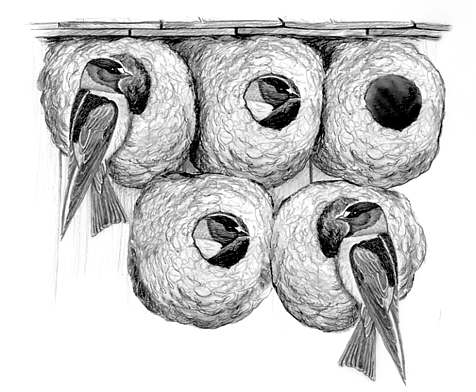
Dear Bird Folks,
I’m planning a trip to California, to visit a friend and perhaps to do a little bird watching. Some birds I’m interested in seeing are those swallows at Capistrano. When is the best time to see them? Will there really be swallows there or is this “swallows returning to Capistrano” thing some kind of Greek Myth?
-Max, New Rochelle, NY
What kind of myth Max?
I don’t want to put words in your mouth, but could you possibly mean “urban myth”? I doubt Greek Mythology played a major roll in the development of Southern California. The full name of the town, where the swallows return, is San Juan Capistrano. I’m not an expert on the subject, but to my ear that name has a little Spanish ring to it. I think if those swallows were part of Greek Mythology they would most likely be returning to someplace with a more Greek God sounding name like, San Juan Zeus-istrano. And instead of eating insects the swallows would swoop around scooping up hunks of baklava.
No, the swallows returning to Capistrano is not a Greek Myth. However, the story most certainly could be an urban myth…. but it isn’t.
The old mission in San Juan Capistrano started back in 1776. While people here in the East were busy finishing up the paperwork for a new country, a guy from Spain was working hard on the West Coast making sure that the native people believed in the correct religion. To help them believe, a great church was constructed. The church took nine years to build and was only used a few years before an earthquake flattened most of it. The earthquake wasn’t a positive thing for that Spanish guy or for the people who where inside the church during the earthquake, but the birds loved it. The grand church was never rebuilt, but enough of it remained to offer shelter to swallows that were looking for a place to nest.
The swallows of Capistrano are the handsome Cliff Swallows. As you may have guessed by the name, Cliff Swallows look for cliffs in which to build their nests. The cliff they need doesn’t have to be some kind of crazy hunk of overhanging rock, sticking out hundreds of feet in the air. Any overhang will do. The old mission had tons of these overhangs and the birds flourished. Not only did the birds flourish in Capistrano, but they flourished nearly everywhere humans went. The encroachment of humans and their buildings, which caused so much difficulty to most other creatures, were welcomed by the swallows. Barns, sheds and bridges all make excellent manmade “cliffs” for the birds to nest under. They took advantage of the new digs and expanded their range.
Cliff Swallows build gord-shaped nests that are made out of hundreds of mud balls. The birds fly down, scoop up lovely beak-fulls of mud, and wad them into little balls, like we do with bubble gum. The mud balls are stuck under an overhang one at a time until a completely enclosed chamber, with a long entrance tunnel, is formed. Cliff Swallows were into adobe building long before it became fashionable.
Cliff Swallows nest in tight colonies. In the East (yes, we have Cliff Swallows around here) the colonies are fairly small, but out West, you can find thousands of them nesting in one location. A concentrated colony has both advantages and disadvantages. Occasionally some bonehead will decide that the birds are too messy and will wipe out the entire colony of nests, in the name of neatness. Jerk. On the other hand, by living together the birds are better able to find food. Birds that are having trouble locating food, which is flying insects – not baklava, simply watch the birds that are returning with a load of bugs for their babies. The hungry birds will then follow the successful hunters to the nearest swarm of insects and join the fun.
Cliff Swallows spend their winter months way down in southern South America. They begin to arrive in California in late February. The PR people at the mission want us to believe that the birds return each year on exactly March 19th. It’s the miracle of Capistrano. In most cases the birds are back in the area much sooner than that, but I’m not going to rain on their parade. I don’t want any earthquakes coming my way.
The grounds around the old mission are beautiful, but the area just outside the walls has become overdeveloped. Fewer open areas mean fewer flying insects, less food and fewer swallows. The swallows are still there Max, but the day may come when the swallows returning to Capistrano will be nothing more than an urban myth. However, I doubt if it will ever be a Greek Myth. Not unless the birds learn to eat baklava.